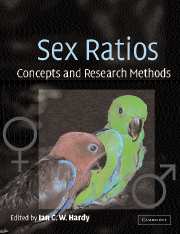Book contents
- Frontmatter
- Contents
- List of contributors
- Preface and acknowledgements
- Part 1 Sex ratio theory
- Part 2 Statistical analysis of sex ratio data
- Part 3 Genetics of sex ratio and sex determination
- Chapter 7 Sex-determining mechanisms in vertebrates
- Chapter 8 Sex determination in invertebrates
- Chapter 9 Sex ratio distorters and their detection
- Part 4 Animal sex ratios under different life-histories
- Part 5 Sex ratios in plants and protozoa
- Part 6 Applications of sex ratios
- Index
- References
Chapter 8 - Sex determination in invertebrates
Published online by Cambridge University Press: 06 August 2009
- Frontmatter
- Contents
- List of contributors
- Preface and acknowledgements
- Part 1 Sex ratio theory
- Part 2 Statistical analysis of sex ratio data
- Part 3 Genetics of sex ratio and sex determination
- Chapter 7 Sex-determining mechanisms in vertebrates
- Chapter 8 Sex determination in invertebrates
- Chapter 9 Sex ratio distorters and their detection
- Part 4 Animal sex ratios under different life-histories
- Part 5 Sex ratios in plants and protozoa
- Part 6 Applications of sex ratios
- Index
- References
Summary
Summary
Invertebrates display a great variety of different sex-determining mechanisms. While sex determination may be quite conserved in some taxa, in others it differs between closely related species or even between different populations of the same species. Sex determination and sex allocation tend to evolve interactively through the common medium of sex ratio selection. However, sex ratio conflicts can occur due to differential selection upon genes acting in different individuals (e.g. parent versus offspring) or with different transmission patterns (e.g. nuclear versus cytoplasmic). Sex ratio selection, especially when there is conflict, is probably of key importance in generating the turnover of sex-determination systems to produce the great diversity observed. Most sex-determining mechanisms can be classified as primarily genetic (GSD) or environmental (ESD) but in some cases both influences are important. In addition, cytoplasmic sex factors may be present (Chapter 9). Selection for adaptive sex ratio patterns may sometimes achieve similar endpoints using different raw material. For example, patterns of association between offspring gender and patch quality may be achieved through zygotic ESD or via genes influencing maternal behaviour in certain GSD cases. At a different level, common GSD systems, such as male heterogamety, are known to be underpinned by different molecular mechanisms.
Introduction
Sex determination refers to the genetic and environmental basis of an individual's gender and is consequently of great relevance to considerations of the sex ratio.
- Type
- Chapter
- Information
- Sex RatiosConcepts and Research Methods, pp. 178 - 194Publisher: Cambridge University PressPrint publication year: 2002
References
- 22
- Cited by



